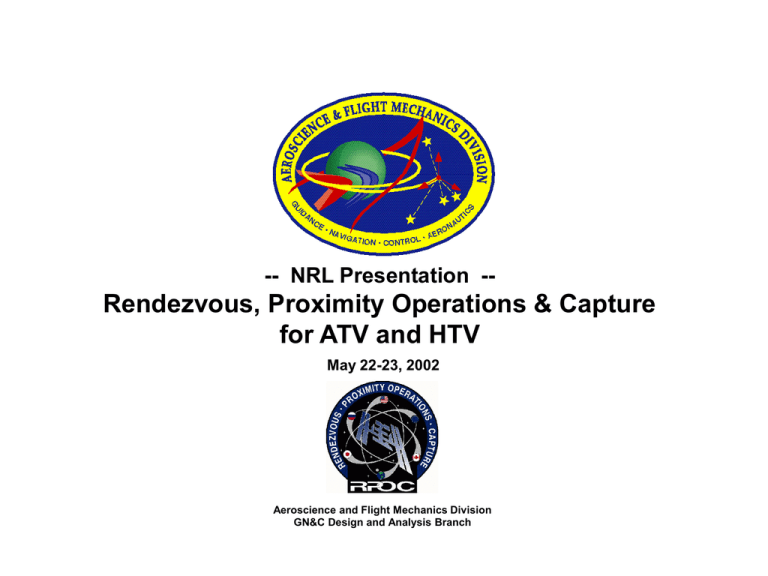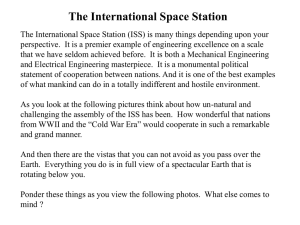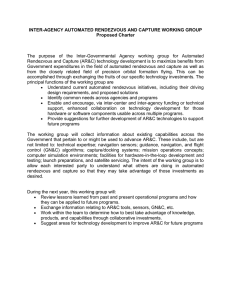Rendezvous, Proximity Operations & Capture for ATV and HTV May 22-23, 2002
advertisement

-- NRL Presentation -- Rendezvous, Proximity Operations & Capture for ATV and HTV May 22-23, 2002 Aeroscience and Flight Mechanics Division GN&C Design and Analysis Branch Big Picture • ATV/HTV – Endorse Certificate of Flight Readiness (Safety first) • • • Vehicle Integration/Compatibility with ISS Assessment of mission success Flight Aspects – – – – Principal role • • Interface and negotiate with International Partners on behalf of ISSP Independent Assessment of GNC/Flight Systems/Mission Design and ISS Interfaces from perspective of requirements, limitations and capabilities – – – – • Analysis Analysis Analysis Analysis of GNC sensors, effectors and algorithms and review FDIR requirements, design and capabilities of trajectory requirements, design and safety through simulation and review of verification methods, coverage and limitations Integration with ISS – – – – – EG Education May 22-23, 2002 Rendezvous, Proximity Operations, Capture/Docking/Separation, Departure Emphasis on Demonstration mission -- first flight Contingencies Analysis of vehicle control for docking/capture performance (nominal and contingencies) Analysis and review of monitoring requirements, design, capabilities and options through simulation and prototyping Analysis and review of command and control requirements, options and capabilities Development, analysis, and review of ICD, IRD and SSD requirements and verification Formal Reviews (Safety, PDRs, CDRs...) Page 2 Rendezvous Proximity Operations & Capture RPOC Customers and Interfaces SAFETY VERIF NE ISS Avionics Launch Package Team OD OM OB OPS CREW CB DM/DO ER/DX Russian IPT ESA EADS Controls Navigation Guidance FDIR Simulation and Modeling Trajectory Systems Engineering Flight Systems Visualization Logistics RSCE RSCE* NASDA USOS GNC COMM C&DH OD EV EV EG Education May 22-23, 2002 ROBOTICS Mission Integration S/W CSA MHI MELCO *Russian Vehicles OM Page 3 Rendezvous Proximity Operations & Capture Docking and Berthing • • • V Bar Approach Rendezvous & Proximity Operations Nav – Relative GPS – Laser Reflectors – ISS-to-Vehicle Communication link – Russian ARD at their ports Docking – APAS -- Androgynous Peripheral Attachment System Shuttle/PMA – Probe & Cone Soyuz Progress ATV Robotic capture & berthing – CBM -- Common Berthing Mechanism HTV – External attachment sites External payload sites, truss S2 & P2 JEM Exposed Facility -V Bar Approach P A C Robotic Capture Box Soyuz, Progress, & ATV A P P HTV Soyuz & Progress A = APAS P = Probe & Cone +R Bar Approach C = CBM External Payload Sites EG Education May 22-23, 2002 Page 4 Rendezvous Proximity Operations & Capture Automated Transfer Vehicle (ATV) • Automated Transfer Vehicle from the European Space Agency (EADS-LV) – – – – – – – – – – No people; cargo only Performs automated rendezvous and docking to Service Module - same port as Progress Delivers propellant, water, gas, pressurized cargo … departs with waste Performs ISS reboost, debris avoidance maneuvers, and attitude control while attached Launch vehicle is the Ariane 5 (French; launched from French Guyana) First flight is planned for September ‘04 Annual launches with six month stay at ISS Navigation sensor suite include: • GPS receivers on ATV and in ISS Service Module (position, velocity) - requires ISSto-ATV communication link for transfer of ISS data to ATV • Laser (range, range rate) - Telegoniometer • Vision sensor (range, range rate, angle, angle rate) - Videometer Attitude sensor suite include: • Gyroscopes (attitude rate) • Earth sensors (angles) • Horizon sensors (angles) Automated activities include: • Software moding - preset activities applicable to specific flight phases • Preset maneuver computation – • • • EG Education May 22-23, 2002 Flight maneuver computation including Collision Avoidance Maneuvers - accomplished by preset activities included in multiple software modes Fault Detection, Isolation and Recovery Abort recognition and execution Response to a limited number of ISS Crew commands - e.g., Hold, Retreat, Resume, Escape, Abort Page 5 Rendezvous Proximity Operations & Capture ATV the movie EG Education May 22-23, 2002 Page 6 Rendezvous Proximity Operations & Capture ATV Description (1) Pre-homing Station keeping • Prox. Link acquisition • R-GPS convergence • Homing maneuvers computation • GNC parameters checked by ground • GO for homing by ATV-CC + 1 orbit for contingencies Approach Ellipsoid Keep Out Sphere X = - 250 m, Z = 0 m S4 V (X = - 3500 m, Z = -100 m) 30 km S2 S3 Final Approach Closing ~40 min Pre-homing Homing 40 min 1/2 revolution > 20 min R S1 > 10 min < 65 min S0 S-1/2 Escape Free drift Sun pointing attitude - Maneuvers performed with ACS (4 PDE) Navigation sensors in hot stand-by redundancy EG Education May 22-23, 2002 Page 7 Propulsion : ACS - 2 PDE Rendezvous Proximity Operations & Capture ATV Description (2) Videometer based navigation with relative attitude Videometer based navigation (Telegoniometer based monitoring) Telegoniometer based monitoring Keep Out Sphere -12 m 2-3’ V S41 S4 20’ 10’ S3 Hold - Retreat - Resume (between S3 and S4) capabilities on external commands Escape R EG Education May 22-23, 2002 - 250 m -20 m Local Vertical Local Horizontal attitude Position and attitude control performed with ACS (4 PDE) All sensors in hot stand-by redundancy Page 8 Rendezvous Proximity Operations & Capture ATV Description (3) Docking (0 m) S41 (12 m) S4 (20 m) S3 (250 m) 1 km S2 (3.5 km) ATV Primary GNC sensors Dissimilar GNC sensors Monitoring by MSU ATVCC Gyros + Star Tracker VDM w/Att VDM R-GPS Gyros Telegoniometer Accelerometers + DGPS Telegoniometer + Gyros Accelerometers + Gyros Telemetry data Telemetry data + KURS data ISS crew EG Education May 22-23, 2002 Visual aids for video monitoring Target pattern for video monitoring Page 9 Rendezvous Proximity Operations & Capture S0 HII Transfer Vehicle (HTV) • HII Transfer Vehicle from the National Space Development Agency of Japan (MELCO/MHI) – – – – – – – – – No people; cargo only Performs automated rendezvous to berthing box…is captured with SSRMS and attached to CBM at Node 2 Nadir Delivers pressurized cargo (experiment payloads, consumables, water, etc,.) and unpressurized cargo (experiment payloads, batteries) … departs with waste Launch vehicle is the HII-A (Japanese; launched from Tanegashima, Japan) First flight is planned for November ‘05 Biannual launches with a two week stay at ISS Navigation sensor suite include: • GPS receivers on HTV and in ISS Japanese Experiment Module (position, velocity) - requires ISS-to-HTV communication link for transfer of ISS data to HTV • Laser (range, range rate) - Rendezvous Sensor • Accelerometers (acceleration) Attitude sensor suite include: • Gyroscopes (attitude rate) • Earth sensors (angles) Automated activities include: • Software moding - preset activities applicable to specific flight phases • Preset maneuver computation – • • • EG Education May 22-23, 2002 Flight maneuver computation including Collision Avoidance Maneuvers - accomplished by preset activities included in multiple software modes Fault Detection, Isolation and Recovery Abort recognition and execution Response to a limited number of ISS Crew commands - e.g., Hold, Retreat, Resume, Abort, Emergency separation from SSRMS, HTV thruster re-activation Page 10 Rendezvous Proximity Operations & Capture HTV the movie EG Education May 22-23, 2002 Page 11 Rendezvous Proximity Operations & Capture HTV Description (1) Rendezvous Phase ISS AI Yaw around attitude is availab le AI Station Keep ing CM2 M3 PCM2 MC 3 CAM de mo is plann ed for the de mon stration flight. PM2 Orb it Altitude 3 50 - 4 60km 10km (TBD) HAM2 Phase Ad justing CM1 PCM1 MC2 MC1 PM1' Phase Ad justing M2 HAM1 M1 PM1 300 km Y aw around attitu de is available, excep t at CAM d emo. : Automatic event : Commanding event : ISS state vector upload(CMD) Maneuver sequence go (CMD) • 0.5rev T1 ~0.5rev 1rev (PCM2) (CMD) 0.5rev 1rev ~1.5rev ~0.5rev 24.5 - 52.5rev PM2 M2 HAM1 PCM1 200 km 15min38s 40.5 rev - 71.5 rev 0.5rev ~ 1 rev used 5 - 8rev Sensors – GPS MC3 A1 HAM2 CM2 CM1 M3 PCM2 – Earth sensor 180deg yaw (CMD) +/-90deg yaw around for – around Gyros out of plane maneuver EG Education May 22-23, 2002 Injection to Orbit MC2 +/-90deg yaw around for out of plane maneuver (PCM1) (CMD) Page 12 MC1 1rev PM1' M1 TIME 4.6rev PM1 Core system check out Redundancy checkout ACU CAM string checkout (CMD) HTV separati on EVENT Core system ini tial check out(CMD) Rendezvous Proximity Operations & Capture HTV Description (2) • Sensors used – Relative GPS – Earth Sensor – Gyros – RVS (laser) – Independent R&RR using COMM EG Education May 22-23, 2002 Page 13 Rendezvous Proximity Operations & Capture SAFETY OVERVIEW • • • • System, operations and safety requirements for Rendezvous, Proximity Operations, and Capture (RPOC) are specified in key bilateral/trilateral documents (e.g., vehicle Segment Specification, ISS to vehicle Interface Requirements Document) All safety critical functions are two-failure tolerant for catastrophic hazard All maneuvers which take vehicle trajectory into ISS “controlled” space require ground control center “GO” authorization and are initiated from default “hold” points A Collision Avoidance Maneuver (CAM) can be commanded at any time by any of the following: a) service vehicle’s Fault Detection, Isolation & Recovery (FDIR) system; b) appropriate ground control center; and c) ISS crew • A monitoring capability, which allows for abort/contingency actions, is available for ISS crew to supervise automatic approach (visual, independent range/range rate data, vehicle GNC data, vehicle FDIR data); ISS crew intervention includes a small number of additional commands to control actions of service vehicle (vehicle dependent) EG Education May 22-23, 2002 Page 14 Rendezvous Proximity Operations & Capture Operations Concept Keep-out Sphere (200m radius) 4km V-Bar 2km 3 Sigma Dispersion R-Bar 3 km radius spherical comm coverage Out of plane minor axis of AE is 2km EG Education May 22-23, 2002 Page 15 Rendezvous Proximity Operations & Capture Operations Concept Approach Ellipsoid (AE) Approach Initiation (AI) Maneuver 3 Sigma targeting must stay outside of the KOS Space-to-space communications must be established before AI is performed If the space-to-space link is lost the vehicle automatically aborts Transition of operational authority to the MCC-H 90min prior to AI Keep-out Sphere (KOS) 4Km X 2km X 2km centered on the ISS CG All 3 sigma trajectories must stay out prior to the AI maneuver Crew visibility is required in all lighting conditions within 1 km 200M radius sphere around the ISS Within 200m, vehicle must be within a predefined approach corridor All pre-AI coast trajectories must stay out of AE for at least 24 hours Day of Rendezvous operations (free flight & attached) must fit within 10 hour crew work day Aborts within KOS start with establishing an opening rate On departure, vehicle must exit AE within 90 min of separation on a trajectory that will not re-enter AE EG Education May 22-23, 2002 Page 16 Rendezvous Proximity Operations & Capture CREW COMMAND & ABORT DESIGN • Crew Hardware Button commands for time critical functions – – – – – • Vehicle self-monitoring abort – – • • • EG Education May 22-23, 2002 Collision Avoidance Maneuver (CAM) Vehicle Hold Vehicle Retreat HTV emergency separation in case of failed SSRMS HTV emergency control system activation in case of failed capture two-string system failure communication loss Independent avionics for CAM CAM independent of navigation solutions Abort inside the KOS starts with an opening rate Page 17 Rendezvous Proximity Operations & Capture FLIGHT DEMONSTRATION REQUIREMENTS • • The test program shall demonstrate and verify a readiness of the RPOC system including service vehicle, ISS systems, combined vehicle/ISS systems, and the system support facilities which will be used for a safe RPOC at the ISS All safety-critical functions shall be flight demonstrated: • • • • In a region that is not hazardous to the ISS Prior to when they are needed for ISS safety The technique used by the service vehicle shall be approved by the ISSP Functions to be demonstrated, as a minimum, include: • • • • • • • • • • • EG Education May 22-23, 2002 Establishment of the communications link Command/Data telemetry transfer Functionality of GNC systems Collision Avoidance Maneuver Approach, including maintaining the required approach corridor and stationkeeping Emergency termination of approach Capture within predetermined kinematic parameters Complete mechanical mating and establishment of required interfaces Unmating and back-off Functionality of Service Vehicle ground support personnel and equipment Functionality of visual monitoring techniques and systems by ISS crew Page 18 Rendezvous Proximity Operations & Capture RPOC Tools Shuttle Soyuz Operational Vehicles Progress CRV HTV Vehicles in Development AERCam ATV X-38 Tech. Demonstrators ISS Proposed Future Vehicles Environment Current, Planned, and Generic Robotic Systems • Targeting Algorithms • Guidance Algorithms • Navigation Algorithms • Control Algorithms • Mission & Vehicle Manager Capabilities • Sensors (Gyro, Accel., GPS, Laser, etc.) • Effectors (Jets, Momentum Gyros, etc.) • Propellant Systems (blow-down, slosh, etc.) GPS • Hardware-in-the-loop Communication Systems Crew-in-the-loop - Multi Body • Solar Array Tracking - Rigid Body - Flex Body • FDIR Logic - Orbital - Robotics • Abort Logic - Multi-Vehicle - Contact • Direct and Remote Piloting Capabilities Sim Control, Monitor & Fault Insertion Visualization Kinematics & Dynamics • Crew Interfaces - Collision Detect • Generic Systems (e.g. perfect nav & effector) - Communications Generic Vehicles and Systems EG Education May 22-23, GNC and2002Flight Systems Page 19 Crew Displays - Monte-Carlo - Optimization Mechanism - Math Libraries Models - Multi-Process Rendezvous Proximity Operations & Capture - Multi-Computer Docking/Berthing Support Tools BACKUP CHARTS EG Education May 22-23, 2002 Page 20 Rendezvous Proximity Operations & Capture ISS EG Education May 22-23, 2002 • ISS configuration complex & dynamic • ISS needs about 56,000 kg supplies/year • Six candidate ports for service vehicles, 3 US segment, 3 Russian segment. External sites. • Docking to APAS and P&C, capture and berthing to CBMs (to be discussed) • ISS resources available to service vehicles dependent on attached port, negotiable • ISS orbit characteristics altitude = 350 (275) to 460 km inclination = 51.6 degrees eccentricity < 0.003 (0.01) attitude = -20 to +15 degrees (pitch) Page 21 Rendezvous Proximity Operations & Capture Overview of Vehicles Vehicle (Mass@407 km) Payload (407 km; 51.6º) Shuttle 16,420 kg Soyuz-TM 480 kg Progress-M1 2,230 kg ATV 7,500 kg HTV 6,000 kg CRV Cargo Types • Crew Rotation • Pressurized • Unpressurized • Water, gas Available Date • Available • Crew Rotation • Pressurized • Available • Pressurized • Unpressurized • Propellant • Gas, Water • 1999 • Pressurized • Propellant • 2004 • Pressurized • Unpressurized • 2005 • Crew Return •? TBD kg EG Education May 22-23, 2002 Page 22 Rendezvous Proximity Operations & Capture Shuttle (MPLM) NASA 9,900 3 3 9,900 Shuttle (ULC) NASA 9,900 3 3 700 Shuttle (2x Hab) NASA 10,100 3 3 5,200 Shuttle (Hab/ICC) NASA 9,400 3 3 5,200 Progress M RSA 2,350 1,800 Progress M1 RSA 2,230 1,800 Progress M1+ RSA TBD 1,800 Soyuz-TM RSA 480 3 3 480 HTV (Press) NASDA 7,000 7,000 HTV (Mixed) NASDA 6,000 6,000 ATV ESA 7,500 5,500 CRV NASA TBD 7 TBD Note: All performance measured to 407 Km Note: Each Shuttle flight rotates 3 ISS crew Note: Spacehab estimates based on advertised projections Waste Water (Kg) Recoverable Cargo (Kg) Nonrecoverable Cargo (Kg) Deliver Propellant (Kg) Gas (Kg) Water (Kg) Unpressurized Cargo (Kg) Delivers Racks/ISPRs (Up to # of Racks) Pressurized (Kg) Crew Return (Crewmembers) Crew Delivery (Crewmembers) Maximum Payload Delivered (Kg) Agency Overview of Vehicles (continued) 16 ~400 TBD NA 10,000 75 11,500 ~400 TBD NA 12,700 75 4 450* ~400 TBD NA 5,200 75 4 5,400 ~400 TBD NA 5,200 75 420 40 1,100 1,600 400 40 1,950 1,600 210 40 TBD 1,600 200 20 12 300 7,000 300 8 1,500 300 6,000 300 840 100 4,860 6,500 840 TBD * If unpressurized cargo is loaded on the exterior of the Spacehab module this mass must be reduced in the pressurized module EG Education May 22-23, 2002 Page 23 Rendezvous Proximity Operations & Capture Tools – Simulation/Graphics Environment • • Extensive use of Trick operating system for simulation environment – Model and object based architecture hosting a collection of models and objects allowing multiple simulations with many common models (3, 6, N-DOF simulations) – Strongly data driven - Can largely define systems and events and modify events through inputs – Trick runs on multiple platforms and operating systems • Main platforms: Sun (Solaris 5.8/SunOS 8.0), SGI (IRIX 6.5), PC (RedHat 7.1) • Special support for: Macintosh (OS X), Power PC604 (IRIX GCC/VxWorks), Night-Hawk (Power UX), IBM (AIX), Alpha (True64), PC (Solaris) – Extensive use for H/W-in-the-loop and Human-in-the-loop simulations throughout JSC – Extensive use at JSC for many vehicle simulations - ATV, HTV, CRV, ICDS, On-orbit SES, Sprint, SAFER, AERCam, Russian Vehicles VRTool, VR Lab Graphics (DOUG) and Enigma based graphics EG Education May 22-23, 2002 Page 24 Rendezvous Proximity Operations & Capture ATV/HTV Simulations – Hardware/Software • • • Hardware-in-the-loop Closed-Loop Relative GPS Simulation – Two Force 5 GPS receivers (currently only one purchased) – Plan to use GPS signal generator & RPOC GPS models – Use same methodology/software as developed for AERCam and X-38 Simulations for Integrated Monitoring Development and Evaluation – Real-time – High fidelity graphics – Crew Interfaces – Laptop display capabilities Combined ISS, SSRMS, HTV Simulation for Capture Analysis – ISS GNC System – SSRMS - FSW, Robotics Work Station, Hardware model, boom and joint flex, LEE model – HTV GNC and Flight Systems – Crew Monitoring/Commanding capability – Real-Time for crew interface – Operators Console for test operation and failure insertion EG Education May 22-23, 2002 Page 25 Rendezvous Proximity Operations & Capture ATV/HTV Simulation Summary • • • Simulate All Phases ATV and HTV Near ISS – End part of phasing to proximity operation to capture – Separation and departure – Aborts and re-rendezvous Use Simulations for: – GNC performance analysis – Docking/SSRMS capture analysis – Monitoring development – FDIR analysis – Safety evaluation – ISS integration – Independent Verification Batch Simulations, Avionics-in-the-loop, Human-in-the-loop EG Education May 22-23, 2002 Page 26 Rendezvous Proximity Operations & Capture ATV/HTV Simulation Capabilities • • • • • • Full, Single String, Rendezvous/Proximity Operations GNC for All Phases – Targeting and Guidance used by ATV and HTV and generic – Absolute state navigation • GPS, INS, Generic – Relative state navigation • Relative GPS, laser, vision system, generic – Attitude navigation • Gyro, earth sensor, star tracker, relative attitude, generic – Controls used by ATV and HTV, phase plane, generic – Sensors/Effectors used by ATV, HTV and generic Numerous Flight System Models (comm, C&DH, docking mech. etc.) Limited multiple string instantiation for FDIR analysis Partial ATV and HTV FDIR capabilities ISS model (GNC, array rotation, collision model, etc.) Full SSRMS model (dynamics, controls, FSW, crew interface, etc.) EG Education May 22-23, 2002 Page 27 Rendezvous Proximity Operations & Capture






